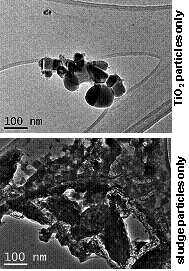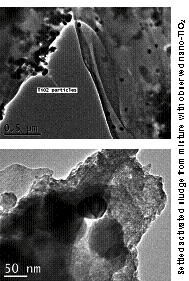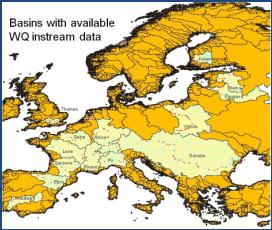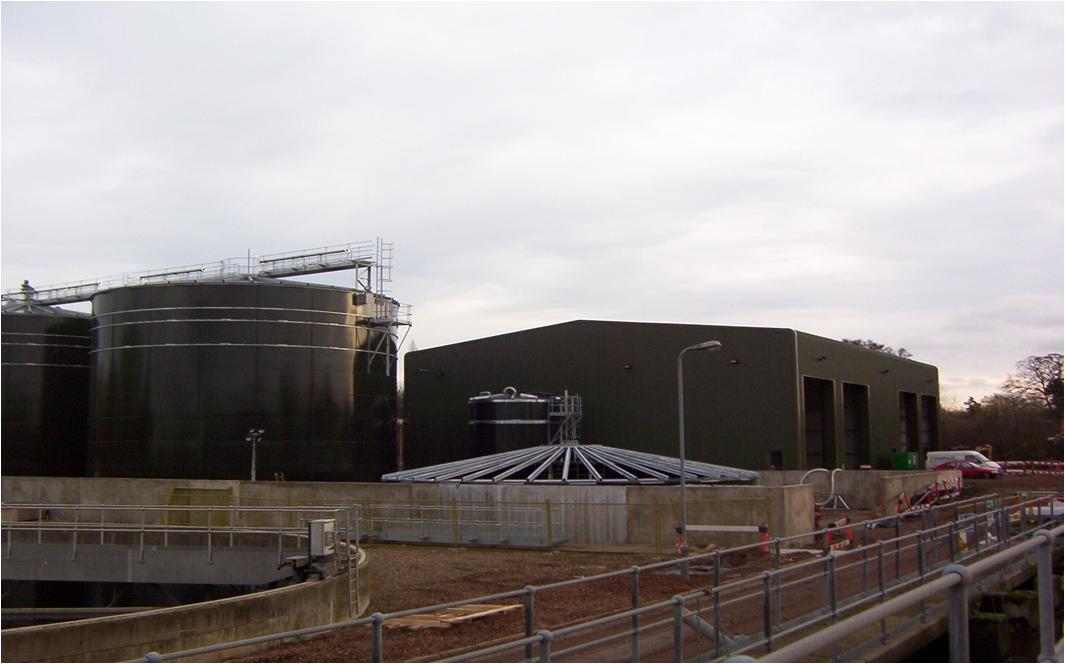Wastewater Forum Archive
WASTEWATER RESEARCH AND INDUSTRY SUPPORT FORUM
Meeting 20th November 2008
Please note that for older reports some links will be to sites that are no longer active.
This was the Forum’s 37th meeting. The meeting ranged from nanoparticles to major river catchments and developments in anaerobic digestion.
 Nanoparticles have had scare stories in the media but Ian Sample, science correspondent of The Guardian, was more accurate when he headlined his article about the Royal Society’s report “Attack of the Tiny Particles - be slightly afraid”.
Superficially, a cause for concern is that nanoparticles are a similar size to virus particles but there is a major difference: viruses have developed special cell entry mechanisms. However it is important that we look at what happens to nanoparticles when they are washed into wastewater collection systems.
Richard Williams, CEH Wallingford described to the Forum an 8-month collaborative comprehensive assessment of the fate, behaviour and environmental risk associated with TiO2 nanoparticle products used in sunscreens in the UK. The authors used Northampton WwTW to model the fate and to sample the process steps.
Nanoparticles have had scare stories in the media but Ian Sample, science correspondent of The Guardian, was more accurate when he headlined his article about the Royal Society’s report “Attack of the Tiny Particles - be slightly afraid”.
Superficially, a cause for concern is that nanoparticles are a similar size to virus particles but there is a major difference: viruses have developed special cell entry mechanisms. However it is important that we look at what happens to nanoparticles when they are washed into wastewater collection systems.
Richard Williams, CEH Wallingford described to the Forum an 8-month collaborative comprehensive assessment of the fate, behaviour and environmental risk associated with TiO2 nanoparticle products used in sunscreens in the UK. The authors used Northampton WwTW to model the fate and to sample the process steps.
Transmission electron microscope (right) showed that the nano-TiO2 partitions strongly to solids and virtually none remain in the aqueous phase. Thus, if there is any risk from nano-TiO2 in sewage, it is not to the water environment. More than 70% of the UK’s sewage sludge (biosolids) is used on land (farming and land restoration) and, because of the partitioning, the nano-TiO2 in sewage will end up in the biosolids, the authors investigated whether there is risk to soil micro-organisms. There were no negative effects on the immune system of earthworms to ranges of concentrations of either in whole worms or when the immune cells were extracted and tested in vitro.

The annual consumption of nano-TiO2 in sunscreen in the UK is 130 tonnes nano-TiO2. If ⅓ of this is applied within the shores of the UK mainly during the summer (June to August) the concentration in sewage entering WwTWs would be 38 µg/litre, assuming that all of the nano-TiO2 ultimately goes down into the sewers rather than being washed off into the sea, swimming pools etc. If only 90% partitioned to the solids, the concentration in the effluent would be 3.8 µg/litre, which is well below the lowest reported effect concentration (LOEL, 100 µg/litre) for rainbow trout. To make the conditions more extreme, the Thames has the largest population and the least dilution (it has been called a ‘cloudy desert’); considering a heat wave, if 25% of adults apply nano-TiO2 sunscreen, which washes off to the sewers and at the WwTWs there is only 90% removal, and the Thames is at low flow, the concentration in the rive would be only 8 µg/litre, again well below the LOEL. The team modelled this to the tributaries and streams and none got to 2% of the LOEL even at low flow and only 90% removal. From this work, the possibility of risk to aquatic organisms or to soil organisms seems extremely unlikely. Preliminary investigation of nano-zinc and nano-cadmium show that their effects are less than these elements in solution.
Richard Williams then described SCENES (Water Scenarios for Europe and for Neighbouring States) , focusing on Work Package 3 – Water Quality Modelling. SCENES involved 23 partners in 17 countries and received 7 million euros contribution from the EU under the 6th Framework. It was coordinated by CESR (Centre for Environmental Systems Research) in Kassel and SYKE (The Finnish Environment Institute) in Helsinki. SCENES’ objectives are to develop and analyse a set of scenarios of Europe’s freshwater future qualities and quantities up to 2050 that will: provide a reference point for strategic planning, alert policymakers and stakeholders and allow river basin managers to test water plans.
It aims to develop an existing water resources model called WaterGAP 2 into a “fine-scale” (5 arc-minutes) model of Europe’s hydrology capable of simulating extreme events. The plan was to develop a  continental-scale model of non-point source loading from agriculture and of point source loading so as to be able to model water quality (coliform bacteria, dissolved oxygen, salinity …). To date SCENES has modelled BOD (biological oxygen demand) and TDS (total dissolved solids); total coliforms, nitrogen, phosphorus, water temperature, dissolved oxygen and “down-the drain” chemicals are in the “to do” list. A substantial amount of data verification is still necessary. The estimates of discharges from industry/manufacturing are still very variable and insufficient for some sectors. There is a need to standardise the methods of measurement and to harmonise the proficiencies of laboratories. The results need to be “ground truthed” by extensive sampling programmes.
continental-scale model of non-point source loading from agriculture and of point source loading so as to be able to model water quality (coliform bacteria, dissolved oxygen, salinity …). To date SCENES has modelled BOD (biological oxygen demand) and TDS (total dissolved solids); total coliforms, nitrogen, phosphorus, water temperature, dissolved oxygen and “down-the drain” chemicals are in the “to do” list. A substantial amount of data verification is still necessary. The estimates of discharges from industry/manufacturing are still very variable and insufficient for some sectors. There is a need to standardise the methods of measurement and to harmonise the proficiencies of laboratories. The results need to be “ground truthed” by extensive sampling programmes.
The first steps of the WorldQual model development have been successful. WorldQual is able to reproduce the right levels of TDS for selected river basins but more work is needed for BOD especially the connection of the BOD decay rate with water temperature. The first scenario runs have been completed for Point Sources. The distribution of annual input data into monthly data needs to be improved. It will be very interesting to see whether the issues of data harmonisation can be overcome so that really meaningful continental-scale models that match what happens in the rivers, lakes, groundwater etc. can be developed.

Finally Professor Andrew Wheatley of Loughborough University reviewed the position of anaerobic digestion (AD) in the UK and his department’s work on the subject. AD is well established; in Europe, about 5 bn wet tonnes of materials are treated by AD each year, but because of inefficiencies, only about 20% of the feed is converted to biogas and 80% passes through. AD has been used for treating sewage sludge for about 100 years; currently in the UK about 70 MW of renewable base-load electricity is generated from sewage sludge biogas (about 10% of a coal-fired power station). This is increasing as companies boost the efficiencies of their digesters and build new ones. For example Northumbrian Water is building AD boosted by thermal hydrolysis that will change its generation from 0.5 MW to 8.8 MW. Water UK estimates the potential for UK is 250 MW, which would be a significant contribution to energy security.
In UK WwTW 10-50% of the biogas is used to heat the digesters (to maintain 35ºC) this could be reduced by pre-thickening the feed sludge because the water has to be heated to and maintained at operating temperature (but there is a viscosity limit for achieving good mixing) and by insulating digesters. In warm climates where ambient temperature >25ºC anaerobic Ww treatment is being installed; this results in less surplus biomass than aerobic treatment.
The advantages of AD for sludges and residuals include that it is well established, it deodorizes, can pasteurise, it conserves nutrients and the digestate is useful soil improver, it is unobtrusive, works at NTP and planning permission is less difficult than windmills. The disadvantages are that it is capital intensive (a 1MW engine costs £1M including commissioning etc.; lignocelluloses resist AD (there are only 4 or 5 organisms (none anaerobic) that break down lignocellulose though Wageningen and Montpellier are working on GM transfer to anaerobes); it generates effluent (dewatering liquor) but nitrogen and phosphorus fertilisers can be harvested from this; and by cleaving peptide links, AD releases ammonia (NH3 is toxic but NH4 is not, so toxicity depends on pH) the tolerance of the process can increase by biomass acclimation. However, regulators and policy makers have been unable to view digestate from the soil’s perspective. Digestate from sewage sludge has one set of regulations, whereas digestate from other inputs has different regulations, but to the soil they are all nutrient-rich soil improver, they earn different amounts of ROCs as well. So co-digestion, which would be eminently sensible, is hindered by regulatory hurdles. Laboratory research at Loughborough has found that the organic [or biodegradable] fraction of municipal waste (OFMSW or BMW) digests better with sewage sludge than it does alone. The biogas yield was 10-20% better and the dewatering properties of the digestate were better.
 Nanoparticles have had scare stories in the media but Ian Sample, science correspondent of The Guardian, was more accurate when he headlined his article about the Royal Society’s report “Attack of the Tiny Particles - be slightly afraid”.
Superficially, a cause for concern is that nanoparticles are a similar size to virus particles but there is a major difference: viruses have developed special cell entry mechanisms. However it is important that we look at what happens to nanoparticles when they are washed into wastewater collection systems.
Richard Williams, CEH Wallingford described to the Forum an 8-month collaborative comprehensive assessment of the fate, behaviour and environmental risk associated with TiO2 nanoparticle products used in sunscreens in the UK. The authors used Northampton WwTW to model the fate and to sample the process steps.
Nanoparticles have had scare stories in the media but Ian Sample, science correspondent of The Guardian, was more accurate when he headlined his article about the Royal Society’s report “Attack of the Tiny Particles - be slightly afraid”.
Superficially, a cause for concern is that nanoparticles are a similar size to virus particles but there is a major difference: viruses have developed special cell entry mechanisms. However it is important that we look at what happens to nanoparticles when they are washed into wastewater collection systems.
Richard Williams, CEH Wallingford described to the Forum an 8-month collaborative comprehensive assessment of the fate, behaviour and environmental risk associated with TiO2 nanoparticle products used in sunscreens in the UK. The authors used Northampton WwTW to model the fate and to sample the process steps.
 continental-scale model of non-point source loading from agriculture and of point source loading so as to be able to model water quality (coliform bacteria, dissolved oxygen, salinity …). To date SCENES has modelled BOD (biological oxygen demand) and TDS (total dissolved solids); total coliforms, nitrogen, phosphorus, water temperature, dissolved oxygen and “down-the drain” chemicals are in the “to do” list. A substantial amount of data verification is still necessary. The estimates of discharges from industry/manufacturing are still very variable and insufficient for some sectors. There is a need to standardise the methods of measurement and to harmonise the proficiencies of laboratories. The results need to be “ground truthed” by extensive sampling programmes.
continental-scale model of non-point source loading from agriculture and of point source loading so as to be able to model water quality (coliform bacteria, dissolved oxygen, salinity …). To date SCENES has modelled BOD (biological oxygen demand) and TDS (total dissolved solids); total coliforms, nitrogen, phosphorus, water temperature, dissolved oxygen and “down-the drain” chemicals are in the “to do” list. A substantial amount of data verification is still necessary. The estimates of discharges from industry/manufacturing are still very variable and insufficient for some sectors. There is a need to standardise the methods of measurement and to harmonise the proficiencies of laboratories. The results need to be “ground truthed” by extensive sampling programmes.